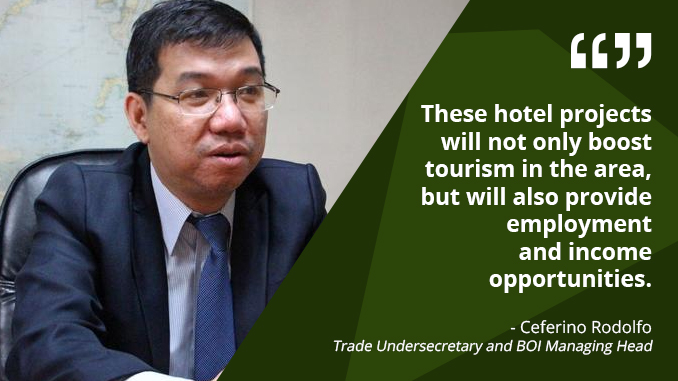The Philippine Board of Investments (BOI) recently approved the Php62.4 million Casa Coco Hotel project of Altipeak Land Development, Inc. and the Php29.1 million Eco Container Hotel of Ecohotels Inc. These projects qualified as tourist accommodation facilities under the current Investments Priorities Plan (IPP).
The Department of Tourism (DOT) endorsed the projects for approval as they meet the minimum requirements of a 3-star hotel. The 30-room Casa Coco Hotel is located in San Juan, Siquijor, which is included in the list of less developed areas (LDAs) identified in the IPP. To drive up economic activity in rural areas and support countryside growth, projects in any of the identified LDAs are entitled to Income Tax Holiday (ITH) incentive of up to six years and additional deduction from taxable income equivalent to 100 percent of expenses incurred in the development of necessary and major infrastructure facilities. The 33-room Eco Container Hotel in Tagaytay City boasts uniqueness as it is made of repurposed shipping containers.
“The Casa Coco Hotel project is a welcome development especially in an LDA such as Siquijor. The hotel project will not only boost tourism in the area, but will also provide employment and income opportunities for people in the area,” said Trade Undersecretary and BOI Managing Head Ceferino Rodolfo.
“To boost tourism, we will continue to encourage the dispersal of economic activities in the countryside. The new hotel in San Juan, Siquijor will accommodate more foreign and domestic tourists with the nearby beaches of Paliton and Poblacion San Juan as main attractions,” Undersecretary Rodolfo said.
“The Eco Container Hotel in Tagaytay City meanwhile will provide unique but comfortable accommodation as the area is one of the country’s rapidly growing tourist attractions. Hopefully, this will inspire other hotels to adopt eco-friendly innovations in the future in response to climate change,” he added.
Ecohotels Inc. in its application for registration stated their containers are made of Corten Steel which is considered very thick, strong and durable. The installation of proper wall and ceiling insulation plus a concrete roof deck at the top floor, combined with passive cooling and excellent cross ventilation, with the option of air-conditioning, will make their container rooms very comfortable and cozy just like any other luxurious hotel room.
Although containers are designed to be stacked-up up to seven levels high without the need for additional structural support, Ecohotels designed the hotel to be only 3 stories high with additional structural support to ensure its safety and comfort. A number of eco-friendly features such as solar panels, water recycling, energy saving lights and upcycled materials will be installed once in operation.
Casa Coco Hotel starts commercial operations in April 2017 with 36 personnel manning the facility while the 33-room Eco Container Hotel starts in April 2017 with 25 personnel.
The DOT registered 5.97 million foreign tourist arrivals and 70.5 million domestic tourists in 2016. Philippine tourism started on a high note in 2017 as foreign visitors reached 631,639 in January, the highest ever recorded figure for a single month, up from 542,258 arrivals from the same month last year. The DOT attributed the record figure to the surge of Chinese tourists and the recently held Miss Universe Pageant.
For 2017, DOT is targeting 6.5 million foreign arrivals and 73.3 million domestic. In addition, the government is targeting revenues of Php407 billion and PhpP1.954 trillion, from the spending of foreign and domestic tourists, respectively. For the long-term, the DOT hopes to achieve 12 million foreign tourists and 89 million domestic tourists by the end of 2022. Under the new National Tourism Development Plan (NTDP), the government has identified tourism as one of the major growth engines of the economy and plans to spend around US$23 billion in the next six years to boost tourism infrastructure and make the industry competitive in the ASEAN region. It envisions building up to 2,620 kilometers of new roads until 2022, from a baseline of 900 kilometers. It also involves the modernization of 11 airports around the country.

